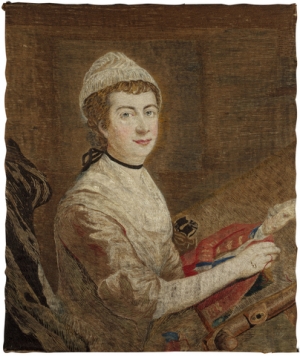 The needlepainting of George III was worked with a combination of satin stitch and long and short stitch, worked on hand-woven tammy. With the money she received from the King her husband could study medicine in Edinburgh, and in Leiden in The Netherlands (in the summer of 1772). She and her husband also had the chance to tour the continent.
The needlepainting of George III was worked with a combination of satin stitch and long and short stitch, worked on hand-woven tammy. With the money she received from the King her husband could study medicine in Edinburgh, and in Leiden in The Netherlands (in the summer of 1772). She and her husband also had the chance to tour the continent.
She is mentioned in James Boswell's The Life of Samuel Johnson, LL.D. for her political ideas (Johnson compared preaching Quaker women to barking dogs) After her husband's death, Mary Knowles joint the Society for Effecting the Abolition of the Slave Trade, and when asked for a poem for a tobacco box, she was very clear about her position as regards slavery. In June 1788, she wrote:
Tho various tints the human face adorn
To glorious Liberty Mankind are born;
O, May the hands which rais’d this fav’rite weed
Be loos’d in mercy and the slave be freed!
See also the anti-slavery embroidered picture from The Netherlands, 1794, and Mary Linwood, another English crafstwoman who made needlepaintings in the late eighteenth and early nineteenth centuries.
Source: JENNINGS, Judith (2007). Mary Morris Knowles (1733-1807). Download here.
Royal Collection catalogue (retrieved 7 November 2016).
WV
King George III, as portrayed in needlework by Mary Knowles (RCIN 11913).
